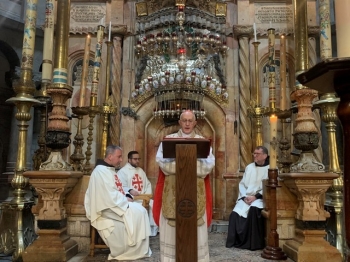The Grand Master made his solemn entrance into the Holy Sepulchre in Jerusalem

Tuesday, May 10, the Grand Master made his solemn entrance into the Holy Sepulchre in Jerusalem. The event had been postponed several times due to the global health crisis. We can read here the reflection he shared at this very important moment.
A pilgrimage to Jerusalem is always a gift from God. This is how it was for the Jewish faithful; it is how it was for Jesus. But how is it for us? Moreover, what is the meaning of this special place for us?
Let me borrow a biblical analogy, I would say a Christological one, from the book of Exodus (chapters 33-34) to answer that question.
The Book of Exodus narrates that Moses, who on Mount Tabor together with Elijah conversed with the Lord, one day said to the LORD: "Show me your glory!" (Ex 33:18). The Almighty then promised to make his goodness pass and show it, and he will be gracious to those to whom he will be gracious and show mercy on those on whom he will show mercy. Then he added: “But you cannot see my face" (Ex 33:20). Then he said again to Moses: “See, there is a place by me where you shall stand on the rock; and while my glory passes by I will put you in a cleft of the rock, and I will cover you with my hand until I have passed by; then I will take away my hand, and you shall see my back; but my face shall not be seen.” (Ex 33:21-23)
These words depicted the mystery of the cross and death of Christ. He, too, will be placed on a rock and then placed in the cleft carved into the rock. A cavity will be covered, the tomb of Joseph of Arimathea, and, like God's protective hand over Moses, a stone will be rolled away at dawn on the third day. The glory of God will then appear in the Risen Lord in the eyes of the unbelieving disciples.
Here, in this very place, the glory of the Risen Lord will reappear in the faith of the believer: Blessed are those who, without seeing, will believe!
This is today the meaning of making ourselves pilgrims.
Those who live in Jerusalem have the task, I would say the spiritual duty, of witnessing to and telling us about the mystery of God's glory manifested in Jesus.
But we, we come here, as Francis of Assisi used to say, to "see and touch" the Lord: to see his footsteps, to hear his words, to touch the place where he was laid, according to the same encouraging words of the angel: "come, see the place where he lay. Then go quickly and tell...: He has been raised from the dead!" (Mt 28:6-7). He is where God saved us!
You, dear brothers and sisters, children of this "Mother Church" of Jerusalem, have the mission of the angel who encourages us to see where the Lord had been placed.
Thank you for this service to our faithful brothers and sisters throughout the world and in particular to our brothers and sisters - Knights and Dames of the Holy Sepulchre.
We come today in the silence of faith to draw from this well of living water, where we discover "The Lord, the Lord, a God merciful and gracious, slow to anger, and abounding in steadfast love and faithfulness, keeping steadfast love for the thousandth generation, forgiving iniquity and transgression and sin" (Ex 34:6-7)
We come as pilgrims to discover this mystery. Here is the whole meaning of our pilgrimage, of coming to this place.
Here every Knight and Dame who loves this place knows that they draw the meaning of their dignity and will carry with them for a lifetime the memory of their faith in the risen Christ.
Amen!
Fernando Cardinal Filoni
Grand Master
(May 10, 2022)




